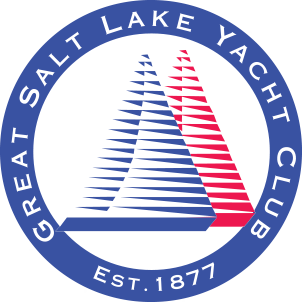History
HISTORY

1824
FINDING OUT ABOUT THE LAKE
The first non-native to view the Great Salt Lake was most likely Jim Bridger in 1824 (who thought it was part of the Pacific Ocean) although there is debatable evidence that either French Canadian immigrant Etienne Provost or former Danish sea captain John H Weber may have visited the Lake as early as 1823 while trapping. The Spanish missionary explorers Fathers Dominguez and Escalante learned of the Great Salt Lake from the Native Americans in 1776, but they never actually saw it getting no closer than Utah Lake forty miles to the south. There was some thought that the lake might be an arm of the Pacific Ocean until James Clyman and three others circumnavigated the lake in 1826 using a “bull boat” which was most likely a type of skin canoe. Interestingly enough, map makers persisted in drawing imaginary rivers draining to the Pacific Ocean for years to come.
1843
Salt Lake City Explored
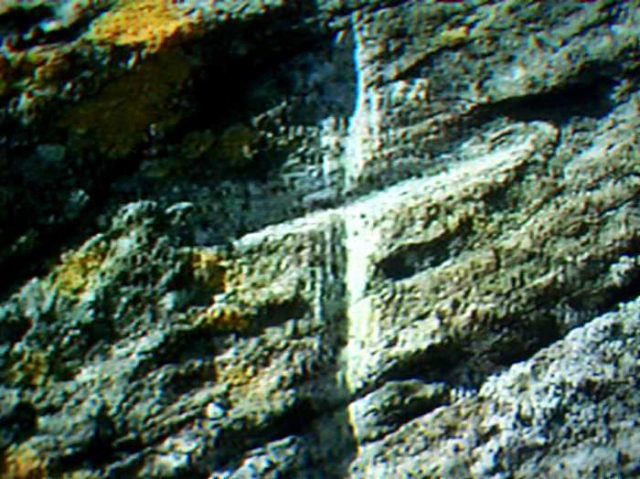
John C. Freemont, Kit Carson and three others explored the lake using an eighteen foot India rubber and canvas boat in 1843. Their explorations included Freemont Island where Carson carved a cross on a rock outcropping which is still visible.
1847-48
First Sailing Craft Launched
The first sailing craft to ply the lake, the “Mud Hen” was launched either August 11, 1847 or April 19, 1848 by Thomas J. Thurston, W. J Potter, Joseph Mount and Stephen Spaulding. This craft was a sailing skiff made of native log wood with a length of 15′ 4″ and a beam of 4′ 4″.
1849
U.S. Government Surveys Lake
Captain Howard Stansbury, accompanied by J. W. Gunnison, arrived by order of the United States Government in 1849 to survey the lake. They had a yawl constructed which was launched April 3, 1850. Two islands in the lake bear their names. The triangulation station they constructed on Antelope Island remains there to this day. Their boat was named “The Salicornia” or “Flower of the Salt Lake” but was generally called “Sally”.
A Variety of Boats on the Lake
By the 1860’s, a variety of steam and sailing boats were being used on the lake. In 1854, the largest boat at the time was commissioned by Brigham Young and launched by Dan Jones. The “Timely Gull” was a 45 foot stern wheeler which was converted to sail in 1856 and destroyed in a storm about 1860. Other boats of the time include the “Star of the West”, a fifty foot schooner, the “Lavon”, the “Pioneer”, a schooner, the “Plubastah” a steamship, “Hope”, also a fifty foot schooner, “Maude”, the “Cambria”, the “Augusta”, “Lilly of the Lake”, “Old Bob”, a cattle boat, and two boats named “Lady of the Lake”, the first being a fifty foot schooner and the other a thirty foot steamer.
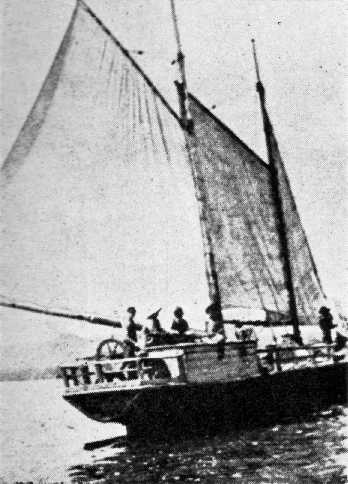
Above is a photograph of the schooner “Lady of the Lake” owned by the Miller brothers and used to transport sheep and cattle to Antelope Island. Built around 1859.
Large Boats Using the Lake
Other large boats included the “Kate Connor”, the “Rosie Brown”, the “Susie Riter”, and the “City of Corrine” later renamed the “Garfield”, a seventy foot, three hundred ton stern wheeler which burned in the 1880’s. The wreckage of nearly all these boats still is found scattered about the shores of the lake. Below is the “City of Corrine”, later renamed “General Garfield”, leaving the pier at blackrock.

Great Salt Lake Yacht Club Established
The Great Salt Lake Yacht Club was originally established on May 10, 1877 with Captain David Lazarus Davis as Commodore. Members included all crew of the vessels: “Waterwitch”, “Petrel”, “Mary Askey”, and an unnamed boat belonging to a Mr. Hudson.
The “Waterwitch” was a vessel of 28 feet with beam of 8 feet. Captain Davis’ first boat was a 19′ cutter named “Eureka”. In the same year as the founding of the Yacht Club, Captain Davis built and launched the “Cambria” which is credited as being the first catamaran launched in the United States. The “Cambria” was built of an ordinary hull split lengthwise and made watertight. She had a ten foot beam and a hull length of 19 feet. The boat has two rudders connected to a single tiller, a bow sprit and flew fore, main and top sails. She was sailed for twenty-eight years.
1886
Large Boats Using the Lake
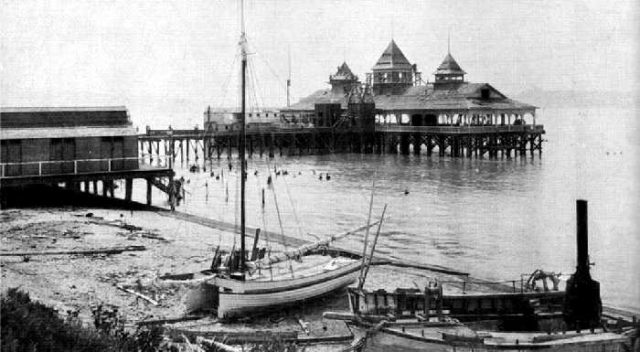
Cambria and another vessel along shore near Garfield Resort (shown here under construction about 1886), another south shore resort. Besides Saltair, the lake was host to Silver Sands, Sunset, Black Rock, Lake Point and Garfield resorts on the south shore as well as Lake Side, Beck’s Hotsprings, Lake Park and Lagoon on the east shore.
1878
Fifth Vessel Joins The Club
In 1878, a fifth vessel and crew joined the Yacht Club, the “America”. Two regattas complete with gold and silver cups were held in 1879. Various cruises and regattas were held throughout the 1880’s and 1890’s.
1901
Captain Davis Builds A New Catamaran
In 1901, Captain Davis built a new catamaran, the “Cambria II” with a hull length of 41 feet, length over all of 65 feet, beam of 15 feet at water line and 24 feet over all. This vessel had both main and mizzen mast and carried 1500 square feet of sail. Captain Davis died April 20, 1926, aged 85.
1925+
Interest in Sailing Renewed
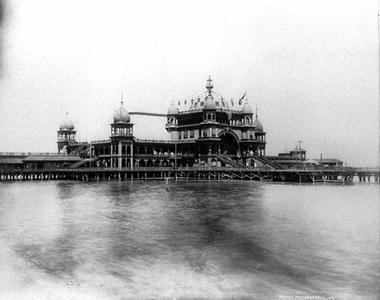
Interest in sailing had faded somewhat after the turn of the century, but had revived by 1925 after the original Saltair resort (built 1893) burned and was rebuilt on the original pilings. In 1929, the Great Salt Lake Yacht Club resumed operations under its original 1877 charter. In 1932, a $200 club house was opened beneath Saltair’s south pier, and the Yacht Club was legally incorporated. The Yacht Club has continued to operate under this 1932 incorporation and 1877 charter to the present day making the Yacht Club among the oldest in the nation.
1930s
Lake levels begin dropping
In the 1930’s, the lake level dropped leaving the boats moored far from shore in unprotected waters. In 1933, construction began on a hand-mortared rock harbor on the location of the present day marina and was worked on throughout the thirties until funds ran out. Portions of this harbor are still visible beneath the rocks of the current breakwater. This harbor was not adequate and plans were made to improve upon it, but World War II interfered.
1950s
Postwar Power Boating Prevails
Saltair was closed during the war years, and it never recovered from the economic blow. Power boating prevailed through the 1950’s. Covered docks were built among the piers, but with the failure of Saltair, motor boating fell by the wayside never to regain any popularity on the lake. There are currently less than a dozen pleasure power boats in use on the Great Salt Lake. Saltair was turned over to the State of Utah in 1959, but the resort was abandoned probably to to the fact that the lake had fallen to record low levels leaving the marina and Saltair far from the water’s edge. Deterioration from wind and salt set it in, and the resort burned to the ground for the second time in 1970.
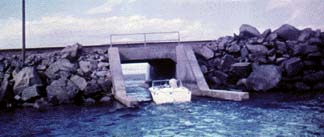
A power boat makes use of a culvert under the causeway in the low water years of the 1960’s.
1960s-1980
Record Lows to New Heights
There was not a lot of sailing going on in the early 1960’s due to the record low lake level which began to rise again in 1964, but the Yacht Club was able to resume activities by 1970.
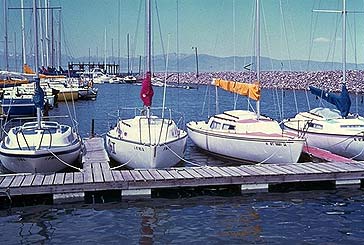
The first 80 mile off-shore race was held on May 10, 1973 with Jack Reynolds placing first and claiming the cup which now bears his name. The club house having deteriorated and burned along with Saltair, the YC had no particular location to meet though a trailer was used at the marina which was pretty much the same as it had been in the 30’s. The Yacht Club had plans of a new marina and clubhouse, but the lake had plans of its own.

Rising water required the harbor breakwater be rebuilt in 1980.
1960s-1980
Record Lows to New Heights
There was not a lot of sailing going on in the early 1960’s due to the record low lake level which began to rise again in 1964, but the Yacht Club was able to resume activities by 1970.

The first 80 mile off-shore race was held on May 10, 1973 with Jack Reynolds placing first and claiming the cup which now bears his name. The club house having deteriorated and burned along with Saltair, the YC had no particular location to meet though a trailer was used at the marina which was pretty much the same as it had been in the 30’s. The Yacht Club had plans of a new marina and clubhouse, but the lake had plans of its own.

Rising water required the harbor breakwater be rebuilt in 1980.
1980s
A new Saltair meets the rising lake
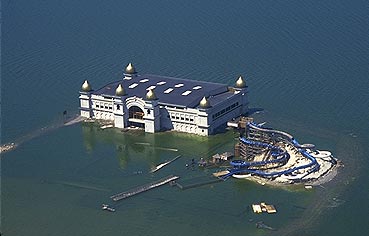
In 1981, a group of businessmen determined to rebuild Saltair by transporting a 36,000 square foot aircraft hangar from Hill Air Force Base and remodeling it into a modern rendition of the original Moorish style architecture.
In 1982, Saltair was a quarter mile from the water’s edge, but 1983 was the wettest year on record in Utah, and by 1984, the lake surface was five inches above the floor of the Saltair pavilion.
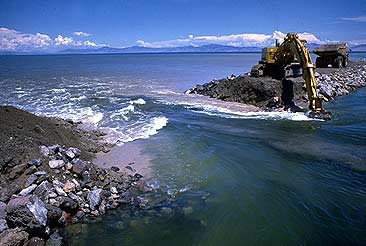
A first attempt to control the rising lake was made by breaching the rail road causeway (which divided the lake in half in 1959) in 1984.
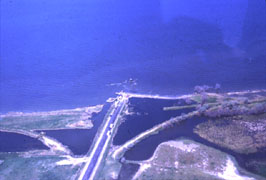
By 1985, the entire harbor, all its facilities, and the access road were completely submerged in record high water.
1980s
Managing the Flooding
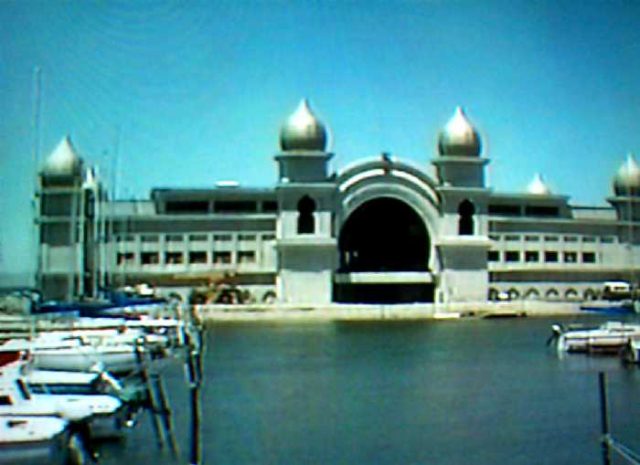
Boats were removed and a temporary marina established in what had formerly been the parking lot for the new Saltair.
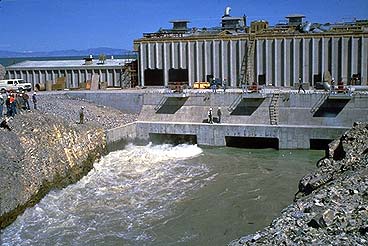
The causeway and harbor breakwater were raised for the third time in 1986 to their current elevations, and the harbor was once again useable. The State of Utah built a gigantic pumping station on the west shore in an attempt to control the rising lake; this pump began operations in April, 1987.
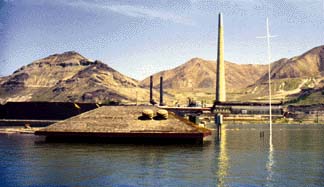
The marina restroom emerged from the depths in 1990 as the water level dropped again. The current marina restroom is built directly on top of the former structure.
1990s – Today
The Yacht Club Builds A New Clubhouse
The Yacht Club determined to build a new clubhouse which was accomplished through an agreement with the state when a pre-built, but never assembled, credit union branch office was transported and erected in the location where the Yacht Club and State Parks Offices now stand. The Yacht Club completed construction on the building in 1992.
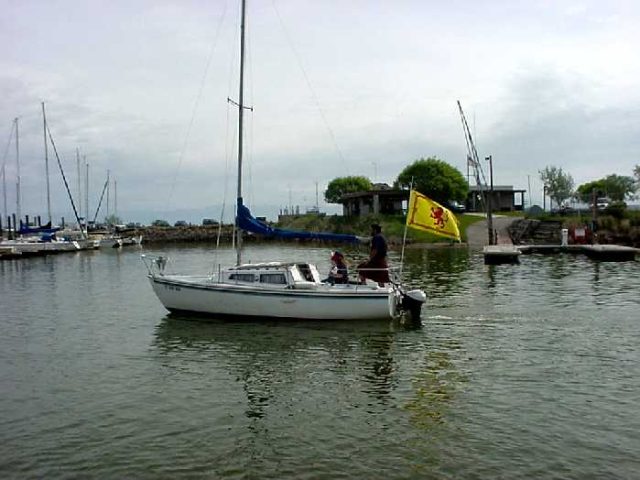
Saltair was able to reopen in the summer of 1993.
The first definitive chart of the the Great Salt Lake is produced by the Great Salt Lake Yacht Club in 1994.
In the year 2000, the Yacht Club began the process of reincorporating to ensure the club’s articles and by-laws are in keeping with current law and practice. The completion of this process has brought the By-Laws and Incorporation documents of the Yacht Club in line with modern law and public policy.
The Yacht Club joined with the State of Utah in planning much needed renovations at the marina in 2002 through 2004. Most of the docks were replaced and new ramps installed as well as an additional dock. Dry storage areas were formally negotiated. New pump out and washing facilities were built. Restrooms were remodeled and brought up to current code.
Bibliography
Two excellent and informative references about the Great Salt Lake and boating related activities are:
- “The Great Salt Lake” by Dale Lowell Morgan, University of Utah Press 1995. (1st Ed. 1947).
- “Small Boat Cruising on Great Salt Lake, Past and Present” by Marilyn Kraczek, Hawkes Publishing 1995.
